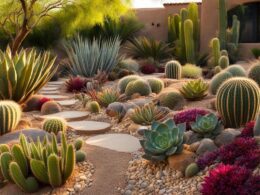Are you looking to transform your garden into a beautiful, eco-friendly oasis without breaking the bank? Look no further! With xeriscaping, you can create a stunning landscape that conserves water and saves you money. Xeriscaping is a drought-tolerant landscaping method that focuses on using minimal water while maintaining a vibrant yard. By incorporating xeriscape principles, you can achieve a low-maintenance and sustainable garden that will impress your neighbors and benefit the environment.
Key Takeaways:
- Create a xeriscape garden to save water and money.
- Incorporate xeriscape principles for a low-maintenance landscape.
- Xeriscaping is beneficial in drought-prone areas.
- Xeriscaping supports water conservation efforts and local ecosystems.
- You can design and implement a xeriscape garden on a budget.
What is Xeriscaping and its Benefits?
Xeriscaping is a landscaping method that focuses on using minimal water to maintain a yard. It is particularly popular in drought-prone areas and can be incorporated into any yard. By using efficient irrigation, incorporating drought-tolerant plants, and replacing traditional lawns with turf alternatives, you can significantly reduce water usage for your garden. Xeriscaping also offers benefits such as lower maintenance requirements, increased return on investment, and support for local wildlife and ecosystems.
So, what exactly is xeriscaping? It’s a landscaping approach that emphasizes water conservation and sustainability. By following xeriscape principles, you can create a beautiful and low-maintenance yard while minimizing water usage. This is especially important in areas with limited water resources and in times of drought.
One of the key benefits of xeriscaping is water conservation. By using efficient irrigation techniques, such as drip irrigation or rainwater harvesting systems, you can reduce water waste and ensure that your plants receive the right amount of water they need. Additionally, xeriscaping promotes the use of drought-tolerant plants, which are well-adapted to survive with less water. This not only saves water but also reduces the need for frequent watering and maintenance.
The Benefits of Xeriscaping:
- Water conservation: Xeriscaping helps you save water by using efficient irrigation techniques and drought-tolerant plants.
- Low-maintenance yard: With xeriscaping, you can reduce the time and effort required for lawn care and maintenance.
- Increased return on investment: Xeriscaping can increase the value of your property by creating an attractive and sustainable landscape.
- Support for local wildlife and ecosystems: By incorporating native plants into your xeriscape garden, you can provide habitat and food for local wildlife, such as birds and pollinators.
“Xeriscaping is not only about saving water, but also about creating a beautiful and sustainable landscape that benefits both the homeowner and the environment.”
In conclusion, xeriscaping offers a range of benefits, including water conservation, a low-maintenance yard, increased return on investment, and support for local wildlife. By implementing xeriscape principles in your landscaping, you can create a beautiful and eco-friendly garden that is both visually appealing and sustainable.
The Seven Principles of Xeriscaping
Xeriscaping is a landscaping approach that follows seven fundamental principles to create a sustainable and water-efficient yard. By incorporating these principles into your design and maintenance practices, you can conserve water, reduce maintenance requirements, and create an eco-friendly landscape. Here are the seven principles of xeriscaping:
- Planning and Design: Evaluate your yard and create a plan that considers water needs, sunlight exposure, and the natural contours of the land. This step helps you determine the best placement of different plant zones and hardscape elements.
- Soil Improvements: Amend the soil with organic matter to enhance its ability to retain water. Well-amended soil promotes healthy root growth and reduces the need for frequent watering.
- Efficient Irrigation: Use water-efficient irrigation methods such as drip irrigation or soaker hoses. These methods deliver water directly to the plant roots, minimizing evaporation and runoff.
- Plant Zones: Group plants with similar water and sunlight requirements together. This allows you to water efficiently and avoid overwatering or underwatering specific areas.
- Mulches: Apply mulch around plants to prevent water evaporation, suppress weed growth, and improve the soil’s ability to retain moisture. Organic mulches such as wood chips or straw are popular choices.
- Turf Alternatives: Consider replacing traditional lawns with low-water turf alternatives, such as native grasses or groundcovers. These alternatives require less water and maintenance while still providing greenery.
- Maintenance: Regularly maintain your xeriscape yard by practicing proper maintenance tasks such as weeding, mulch replenishment, and monitoring water needs. This helps keep your landscape healthy and thriving.
By following these principles, you can create a xeriscape garden that not only conserves water but also enhances the beauty and sustainability of your outdoor space. Remember to adapt the principles to your specific climate and region to maximize the effectiveness of your xeriscape design.
Xeriscaping for Water Conservation and Cost Savings
When considering xeriscaping, one of the main advantages is its potential for water conservation and cost savings. While hiring a professional for xeriscape landscaping can be expensive, there are budget-friendly options available that allow you to create a beautiful, eco-friendly garden without breaking the bank.
One way to save money is by designing and implementing the xeriscape project yourself. This not only cuts down on labor costs but also gives you the freedom to personalize your garden according to your preferences. With a little research and planning, you can create a xeriscape design that suits your budget without compromising on the overall aesthetic appeal.
If you’re concerned about the cost of purchasing new plants, there are alternatives that can significantly reduce expenses. Consider using seeds and plant cuttings, as well as collecting plant divisions from friends and neighbors. These cost-effective options can provide a wide variety of plants for your xeriscape garden at little to no cost.
Additionally, it’s worth exploring turf replacement rebate programs offered by local governments. Many municipalities encourage water conservation by providing financial incentives for replacing traditional lawns with xeriscape landscaping. These programs can help offset the cost of materials and labor, making xeriscaping even more affordable.
Can Mulching Help with Creating an Affordable Xeriscape Garden?
Yes, mulching techniques for xeriscape gardens can certainly help in creating an affordable garden. Mulching helps to retain moisture in the soil, reducing the need for frequent watering. It also helps to control weeds and regulate soil temperature, making it a cost-effective and sustainable option for xeriscaping.
How to Xeriscape Your Yard on a Budget
Creating a stunning xeriscape garden doesn’t have to break the bank. With some DIY spirit and creative strategies, you can transform your yard into a beautiful, water-wise oasis without spending a fortune. Here are some cost-effective xeriscape tips to help you get started:
- Design it yourself: Save money by designing your xeriscape garden yourself. Research xeriscape principles and draw up a plan that incorporates efficient irrigation, soil improvements, and the right mix of drought-tolerant plants. This not only saves on design fees but also allows you to tailor your garden to your specific tastes and needs.
- Opt for seeds and plant cuttings: Instead of buying all new plants, consider starting your garden from seeds or using cuttings from existing plants. This can significantly reduce the cost of purchasing fully grown plants, and it’s also a great way to propagate and expand your plant collection.
- Choose spreading plants: Select plants that have a natural tendency to spread and cover more ground. These plants will fill in your garden quickly, reducing the need to buy multiple plants or spend extra on ground cover materials.
- Use cost-effective hardscape options: Instead of investing in expensive concrete slabs and boulders for pathways and decorative elements, consider using cost-effective alternatives like shells and pebbles. These materials can add texture and visual interest to your garden without breaking the bank.
- Make your own mulch: Mulch is a crucial component of xeriscaping as it helps retain moisture and suppresses weed growth. Rather than buying mulch, consider making your own. Use organic materials like shredded leaves, straw, or grass clippings, which not only save money but also enrich the soil as they decompose.
By incorporating these cost-effective strategies into your xeriscape project, you can create a stunning and eco-friendly garden without exceeding your budget. Embrace your inner DIY enthusiast and enjoy the process of transforming your yard into a water-wise haven.
Conclusion
Creating a budget-friendly xeriscape garden is not only a smart financial decision but also an environmentally-conscious choice. By implementing eco-friendly landscaping tips, you can create a water-wise garden that not only reduces water consumption but also enhances the beauty of your yard.
By following the principles of xeriscaping and incorporating cost-effective strategies, such as DIY work and using plant divisions and seeds, you can create a sustainable landscape without breaking the bank. Making your own mulch further adds to the affordability and effectiveness of your water-wise gardening efforts.
Not only will a xeriscape garden benefit the environment by conserving water resources, but it will also lower your water bills in the long run. Embrace the opportunity to create a beautiful, low-water garden and enjoy the satisfaction of knowing that you are making a positive impact on the conservation of water.











